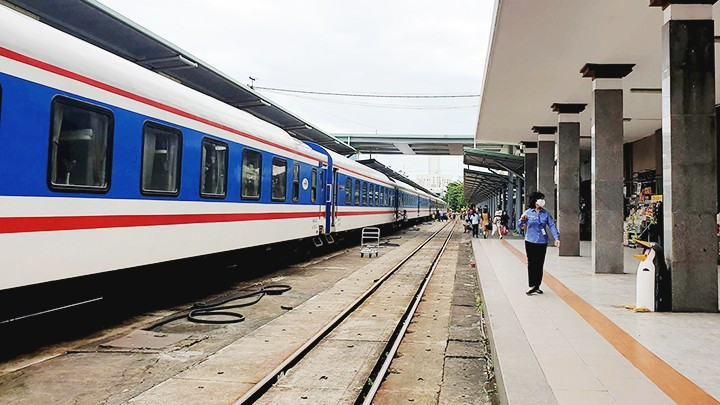A report on the North-South HSR project submitted to the government by the Ministry of Transport on October 1 shows that the entire line will be 1,545 kilometres long, starting from Ngoc Hoi Station in Hanoi to Thu Thiem Station in Ho Chi Minh City, with the total cost expected at over 67 billion USD.
More even population distribution
This HSR line will run through 20 provinces and cities and will primarily be used to transport passengers. It can also carry freight and serve national defence purposes when necessary. Along the line there will be 23 passenger stations, located near the economic and political centres of each locality. The average distance between two stations will be 67 kilometres.
During the construction and operation process, the project will call for investment in service and commerce areas at stations. The HSR project is expected to provide a major boost for the economy, in such aspects as meeting the transport demand, restructuring transport to maximise the advantages of each mode, opening new spaces and resources for economic development through effective land use, and developing the construction and building material industries.
The project will also help with promoting tourism, services and urban development as well as reducing environmental pollution and traffic accidents, enhancing the Vietnamese economy’s competitiveness, and creating millions of jobs. It is estimated that Vietnam’s GDP will increase by an additional 0.97 percentage points each year during the construction of the North-South HSR project.
Utilising land in transit-oriented development (TOD) areas and commercial activities are expected to produce 22 billion USD in revenue, not including fares.
According to Associate Professor Hoang Van Cuong, a member of the National Assembly Committee for Finance and Budget, the project’s 67 billion USD price tag is no longer a major hurdle given the fact that Vietnam’s public debt currently stands at only 37% of GDP and Vietnam’s GDP will reach about 564 billion USD in 2027, when construction is scheduled to begin.
Since the transport infrastructure in many localities has yet to be developed, investors primarily choose to invest in major cities such as Hanoi, Da Nang and Ho Chi Minh City.
Therefore, the HSR project will connect growth centres, enhance regional connectivity, open new economic development spaces, restructure urban areas, and attract investors to not only major economic centres but also other localities.
In addition, the population will also be distributed more evenly as people can reside along the line, thereby fostering economic structural shift and enhancing the competitiveness of the economy. When the transport infrastructure system develops, the areas around stations will no longer be quiet places, but will become busy urban centres along with increases in land values and economic growth.
Higher fares acceptable
According to the proposal, the HSR fares are expected to equal 75% of low-cost air fares. Specifically, one kilometre of travel will cost 0.18 USD for first class, 0.074 USD for second class and 0.044 USD for third class. So, to travel the entire length of 1,541 kilometres from Hanoi to Ho Chi Minh City, passengers will have to pay about 6.9 million VND for first class, 2.9 million VND for second class and 1.7 million VND for third class.
Dr Phan Le Binh, head of the Japanese consultant OCG’s Hanoi office, stated that once completed, the North-South HSR project will shorten the distances between localities and regions, thereby reducing population density and infrastructure overburden in major urban areas, especially Hanoi and Ho Chi Minh City.
At the same time, famous and potential tourist sites will have the opportunity to attract more visitors from around the country and the world, creating an impetus to develop accompanying services such as hotels, restaurants and retail.
In many cases, passengers will accept HSR fares that are higher than air travel because they do not have to spend time travelling to the airport and waiting for take-off and landing. In the meantime, they can get on a high-speed train and work as usual thanks to the availability of internet connection. With this benefit, HSR fares do not necessarily have to be cheaper than airplanes.
Regarding the localisation capacity, the scheme noted that Vietnam can master the entirety of the construction, operation and maintenance work, and gradually manufacture a number of replacement parts domestically.
However, with a small market like Vietnam, it is not feasible to establish a factory that only sells a few products a year, said Dang Sy Manh, Chairman of the Vietnam Railway Corporation (VNR). Therefore, in addition to proposals for preferential loans, land tax and corporate income tax, the corporation has also proposed policies for placing orders and guaranteeing that its products will be purchased during the initial phase.
Manh added that to date, VNR is capable of assembling and manufacturing trains with a domestic content rate of 70-80%. Therefore, the government can place orders for equipment with the VNR, which then will assess the market and collaborate with both domestic and international partners, which the VNR already has experience in.
The government is scheduled to seek the National Assembly’s approval for the HSR project at its upcoming plenary session in October 2024. A feasibility report will be conducted in 2025-2026 and construction is scheduled to start in 2027, with completion scheduled for 2035.
According to experts, such a roadmap is rather challenging because currently urban rail projects are being implemented very slowly due to the lack of an “engine” to address the differences between project owners and contractors. Above all, accelerating administrative procedures is the most important task. Once this is addressed, other issues will be settled quickly.
According to the Ministry of Planning and Investment, the North-South high-speed rail project will create a construction market worth 33.5 billion USD. Including the national railway system and urban railways, the construction market value will amount to 75.6 billion USD, including 34.1 billion USD in rolling stocks, signalling and other equipment. The HSR project will also create millions of jobs.
















